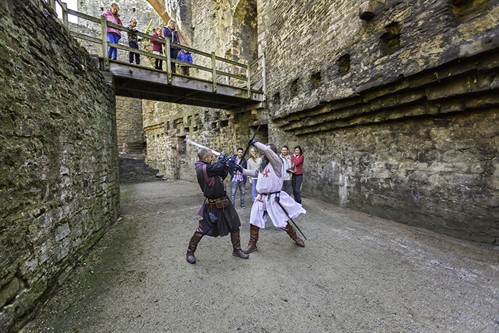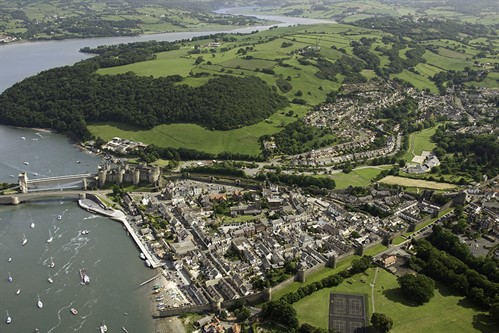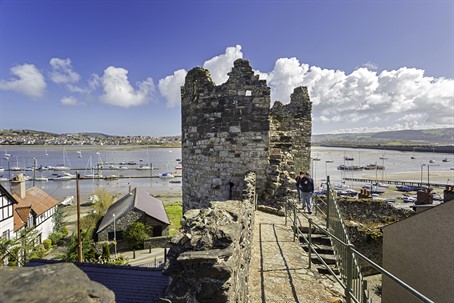Posted on 03/05/2017 by David
There are many, but we think Conwy is arguably the most historic town in North Wales. A long history combined with well-preserved remains has visitors flocking to experience it from all over the globe.
You could fill a library with the books written about it, but is it a case of read one, read them all? It's true, many tell the same same tales of the walled town so in this week's blog we're delving into the archives to uncover some of the lesser-known stories of Conwy and its castle.
First, we need to set the scene. Here's a brief history of Conwy's most iconic residence - Conwy Castle.

The history of Conwy Castle
Conwy was originally the site of an important religious settlement, Aberconwy Abbey. It belonged to the powerful Cistercian order and was a favourite of the Welsh princes who patronised and protected it. Just across the river, the garrison of Deganwy Castle - the forerunner of Conwy Castle - kept a watchful eye over the monks. And then the Normans arrived.
From the late 11th century, Welsh princes and English kings were locked in a power struggle for control of North Wales. Edward I - nicknamed the 'Hammer of the Scots and the Welsh' for his hardline military tactics - eventually emerged triumphant when in 1282 he swept across the region with a large army.
In a clever two-pronged attack - from Chester on one one side and Carmarthen on the other - Edward captured Conwy in 1283. Seeing the strategic importance of a riverside stronghold, he abandoned the hilltop Deganwy Castle and chose to build a castle across the River Conwy (an unofficial border between the Welsh and English) deep in Welsh territory. The message sent by such a move was one of colonialism and subjugation. Edward and the English were here to stay.
With Edward's trusted engineer, James of St George, at the helm the castle was completed in just 7 years with no expense spared. It was one of a string of fortresses built across North Wales as part of Edward's infamous Ring of Iron.
The Ring of Steel was meant to intimidate and terrify the conquered Welsh but, for many patriotic warriors, the castles had the reverse effect. From 1400, a rebellion led by exiled prince Owain Glyndwr involved a surprise attack on Conwy.
Disguised as workmen, Owain's cousins gained entry to the castle and quickly took it. For three months the rampant lions of House Glyndwr's flag fluttered from the ramparts until the rebels finally surrendered - but not before cannily securing a royal pardon from King Henry IV.
From the mid-fifteenth century, Conwy's strategic importance began to wane. It played a small role in the Wars of the Roses and was used as a prison during the Tudor period. In 1627, King Charles I sold it to Englishman Edward Conway (an ancestor of our present Queen) for the princely sum of £100.00. But, as a leading politician and soldier, Conway's sights were set well beyond Wales and he stripped the castle and sold off its assets, even selling timber to pirates for shipbuilding!
From then until the end of the 18th century, Conwy Castle slowly crumbled - its ruins considered romantic by poets, artists and tourists - until 1953 when it was purchased and renovated by the Ministry of Works.
It became a World Heritage Site in 1986 and finally came under the stewardship of CADW (custodians of Welsh heritage) who welcome over 180,000 visitors a year to the castle.

The legends of Conwy Castle
The Mermaid’s Curse
One of the many legends linked to Conwy, the Mermaid's Curse is also one of the most chilling. Many years ago fishermen caught a mermaid in their nets while fishing on the Conwy Estuary. A fish out of water, the terrified mermaid pleaded to be returned to the sea but the fishermen refused, choosing to parade their catch-of-the-day through the streets.
Eventually, like any water-dwelling creature, the mermaid began to suffocate. With her last breath the mermaid cursed the men of Conwy and the land itself, vowing that the town would suffer war, disease and poor harvests for eternity.
Locals believe the mermaid died on the spot now occupied by the town hall. In 1966, the building burnt to the ground and some Conwy folk claim to have heard the mermaid’s ghostly laughter through the flames. The building was rebuilt but burnt down again just two months after completion - you guessed it, her eerie laughter was heard again.
Paranormal activity
Lots of castles have spooky tales, and Conwy Castle is no different. The apparition of a monk is seen from time to time, lamenting to desecration of his cherished abbey, and a strong smell of incense has been reported on entering the upstairs floored chapel within the castle walls.
A black silhouette has been spied watching visitors, and many people report becoming overwhelmed with terror whilst in the towers, fleeing the castle, even in daylight! Some people event say that they’ve seen a large man in armour illuminated by candlelight through one of the tower windows.
Most recently, the voice of a ghostly child was recorded in one of the castle's towers. It was recorded by a local paranormal investigation team - have a listen and judge for yourself, click here.
Outlaws
In the late medieval period, English kings struggled to keep the strategic corridor between Wales and England open. Conwy was situated at the crossroads - on one side, the settled Norman lands of north eastern Wales and on the other the wild Snowdonian heartlands of the Welsh rebels.
The rebels made life incredibly difficult for their conquerors, dashing down from the foothills in lightning raids on English settlements before disappearing back into the hills along sheep tracks and hidden paths.
In 1294, Madog ap Llywelyn rebelled against English rule. Madog and his men besieged Conwy in a tense stand-off that lasted for months. The garrison, headed by Edward I himself, was only able to hold out so long thanks to provisions delivered by boat. The English navy arrived to end the siege and, in perhaps one of his few compassionate acts, the king shared his own wine among the garrison soldiers as a reward for their tenacity.
Jackdaws
Jackdaw, or Jac-do in Welsh, is the nickname given to someone born within the walls of Conwy. The Jackdaw Society, a club for Conwy residents born and bred, was set up in the 19th century. It existed to raise money for charity, heighten the profile of Conwy and boost community spirit.
Sadly, it was disbanded in 2011 due to dwindling membership; because of advances in maternity care, few people are born at home anymore. The few remaining members, in their 80s and 90s, felt they were too old to carry on the good works of the society.
The reason for the nickname? Inspiration was taken from Conwy's unofficial mascot - the jackdaw. The castle walls provide the perfect nesting spot for wild jackdaws and the cheeky black birds are seen all over town, unlike their human counterparts.

Conwy has so much to discover (take a look at our blog about Hidden Conwy for an alternative sightseeing itinerary) and there are many more stories to discover about this wonderful, historic town. If you know of any, we'd love to hear them and will feature our favourites in an upcoming blog!

